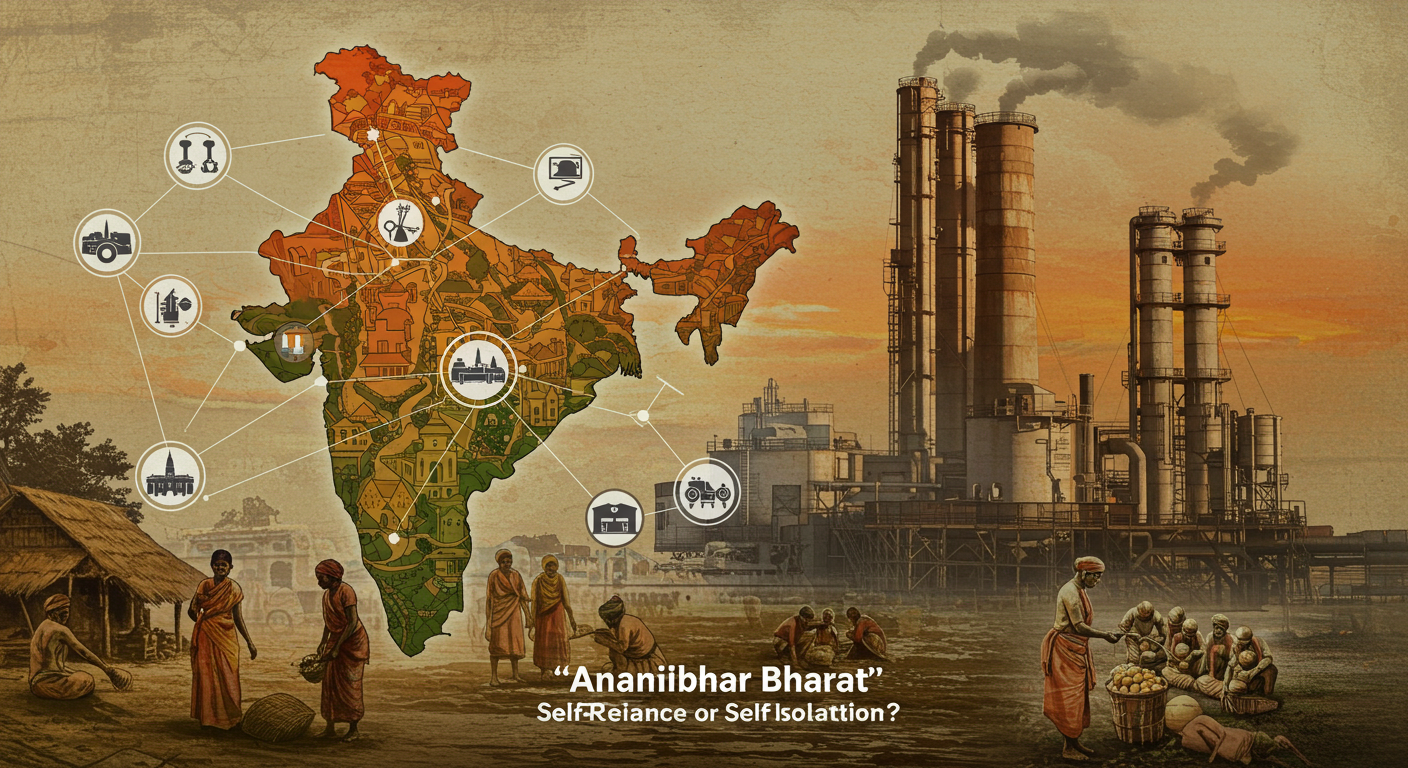In the wake of the outbreak of Coronavirus and the military standoff at the LAC with the People’s Republic of China, Indian Prime Minister Narendra Modi launched Atmanirbhar Bharat.

The mission was launched to put the ravaged economy back on track with an aim to make it self-reliant and self-sufficient. There was an emphasis on self-reliance to reduce the imports that flood the market, especially from the Chinese to firmly respond to the unwarranted military aggression along the LAC.
Though the government claims that Atmanirbharta does not mean being in self-isolation yet the tariff rates increase on imports and India’s unwillingness to be a part of the Free Trade Agreements such as the RCEP has raised doubts that Atmanirbharta is the return of import-substitution industrialization turning India into a protectionist economy.
Thus, I will be exploring through this article whether Atmanirbhar Bharat is pushing India towards isolation from world trade and the impacts of such a move.
Import Substitution Economy (ISI)
Before we discuss India’s tryst with import-substitution industrialization and Atmanirbharta, I would like to explain what an import-substitution economy is.
An import substitution economy “discourages imports of manufactured goods to promote domestic industries and reduce their dependence on foreign trade” (Irwin 1).
The concept of an import substitution economy emerged after World War Two when economists from the field of development economics like Prebisch and Myrdal believed that “the prospects of developing countries achieving economic growth through trade were slim” (Irwin 2). They pushed for industrialization as the primary means of development and were against specialization for trade as it hindered the development of manufacturing bases.
Moreover, believing that the market prices “would not produce the right allocation of resources” (Irwin 4), they promoted government intervention to organize resources and mobilize capital needed for development effectively. All of them advanced the idea on a very narrow basis.
The economists stood for change in the composition of imported goods, from consumer to capital, and regarded export growth as paramount to meet the demands of foreign exchanges. This would ensure that the rise was sufficient and there was no need to restrict imports. But they were not uncritical supporters of this idea.
They warned that a massive protection and government bias on the allocation of resources would be detrimental for economic growth as it would wipe out competitiveness and quality goods from the market. This would “prevent firms from achieving scale economies”.
Unfortunately, their fears came true which led to the demise of import substitution industrialization.
This caused a plain inefficiency as there was no competition and the misallocation of resources due to widespread corruption and biases for certain sectors that happened in countries of Asia and Latin America like Pakistan and the Philippines weakened the support for the concept.
Then, the economic success enjoyed by countries like Taiwan and South Korea due to incentivization for exports signaled the demise of import substitution industrialization.
India’s Tryst with Import Substitution Industrialization
Now, let us move forward to discuss the trends of Import Substitution Industrialization (ISI) in India.
After gaining independence in 1947, India adopted the classical ISI to develop and maintain self-sufficiency in production by promoting MSMEs to ensure the development of domestic supply chains and eliminate poverty.
The government became centralized and restrictive, applying import quotas, financial incentives to some private sectors, large state sectors, and significantly high tariffs leading to a License Raj.
However, this approach was a complete failure. Apart from the aforementioned reasons for failure for the ISI, there was a creation of an inverted duty structure with the import rates of raw material being higher than the finished products that crippled the manufacturing industry and eventually created a deficit crisis.
To get out of the deficit crisis, India liberalized its economy in 1991 and adopted a Look East Policy.
As a result of these, India significantly reduced its tariff rates and signed FTAs with many ASEAN and SAARC member nations to emerge as the fastest growing and 5th largest economy in the world with a 6.5% growth in real GDP from 3.5% during the License Raj (Subramaniam and Chatterjee 21).
But since 2014, there has been a major reversal from the liberalization reforms adopted in 1991. Subramaniam and Chatterjee highlight that “tariffs have been raised, free trade agreements have been put on hold (and a major Asian treaty rejected), and production subsidies have been rolled out” (5).
The most profound impact has been with the change in tariff policy. With 3200 tariff increases, the average rate has increased from “13 percent to nearly 18 percent” (Subramaniam and Chatterjee 5) between 2014 and 2019. Most of these tariff increases have occurred for consumer goods like tires, ACs alike emphasize that an ISI policy is back in play. But this turn towards isolation has increased since the launch of Atmanirbhar Bharat.
Atmanirbhar Bharat emphasizes being vocal for the locals.

![]()
According to Indian PM Modi, self-reliance is the only way to ensure that the 21st Century belongs to India. Building upon his invocation of the two Ds: Demography and Demand since 2014, Atmanirbhar Bharat is based on five pillars: economy, infrastructure, technology-driven system, vibrant demography, and demand.
This again highlights how much emphasis does the central government is basing on domestic market size for the long-run growth.
Now, there are various reasons for this return of inward thinking but for our purposes, we will be focusing upon the reasons India’s overall growth due to trade has not been much and the opportunities for expansion of trade are shrinking due to the emergence of a deglobalizing world order.
Globalisation and India
There has been a belief that globalization has not led India to achieve its growth through manufacturing exports instead India has become a trade diversion ground and its market is now flooded with imported goods.
This fear had been echoed by S. Jaishankar, Foreign Minister who said that globalization allowed subsidized and unfair production advantages from abroad to prevail that has deindustrialized the sector leading to trade deficits, manufacturing cuts, job losses, and over-reliance on imports. But these fears lack evidence.
First, India has had impeccable export growth which has been the key driver for the high GDP growth. This growth has been so profound that in terms of both manufactured goods and services that India is only behind Vietnam and China.
This boom has required India’s imports to sustain them as Subramanian and Chatterjee have highlighted “that exports have been highly correlated with imports (correlation co-efficient of 0.75)” (Subramanian and Chatterjee 21) emphasizing again the need for openness.
Second, for India to realize its dreams of replacing China’s position as the world factory, it is imperative that India cashes upon the opportunities that have emerged due to the shifting of manufacturing bases from China because of fears of over-reliance on China, geopolitical considerations, and Chinese commitment of higher wages for laborers and setting up of domestic supply chains by adopting the Dual Circulation Strategy.
To seize upon the vacuum created, India needs to reduce its tariff rates and create SEZs and allow foreign companies more access to the market especially in low-skill exports rather than closing its doors. This was exactly the recipe for China’s success story after joining the WTO.
Thus, India’s decision to move away from trading arrangements because of their conviction that Atmanirbhar Bharat will help to strengthen itself seems to be misleading.
The rejection of the RCEP is the outcome of this aforementioned misleading belief. RCEP included 10 members of the ASEAN and China, Japan, South Korea, Australia, and New Zealand. The members” make up nearly a third of the world’s population and account for 29% of global gross domestic product” (McDonald).
India rejected the RCEP over its concerns that the proposed decrease in tariff rates and rule of origin formula will lead to flooding of Chinese goods in the Indian market especially affecting the dairy sector. But these concerns are misguided.
The rule of origin states “parts from any member nation would be treated equally, which might give companies in RCEP countries an incentive to look within the trade region for suppliers” (McDonald).
Moreover, the flooding of imported goods is protected by a safety valve provided by the FTAs which protects industries from injury by triggering temporary protection.
Due to all of these factors, China has less to gain in terms of influence when it comes to the RCEP as highlighted in the Economist article, “**Who gains from RCEP, Asia’s new trade pact?**”
Instead, India has missed out on a chance to enter the ready Chinese markets of goods as the RCEP presented a more open China. This would have ensured India increased its quantity of low-skill exports which would have readily increased its global market share and helped reduce its high trade deficits with China.
Besides, this would have allowed companies to compete internationally which would have only resulted in a better quality of goods at low prices which would have been a win for the consumers.
In conclusion, Atmanirbhar Bharat is pushing India towards self-isolation rather than self-reliance.
By analyzing the evidence presented above we come to notice that import substitution industrialization has returned with huge scale tariff increase to reduce, commitment to build and protect the local supply chains, and walking away from major FTAs in order to comprehensively strengthen their national power.
The foundation of this is in the misguided conviction that India can become a manufacturing hub only by domestic self-sufficiency as exports have not played a role in its growth and they will not in the future as the world is deglobalizing. But this is untrue, if the world is deglobalizing then interactions between nations will become transactional then India will lose out if it does not open itself.
The rejection of the RCEP is just the start, if India does not correct its course of Atmanirbharta then it would only act as a roadblock to its growth rather than strengthening it.










